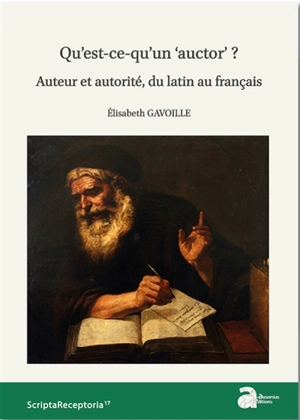
Qu'est-ce qu'un auctor ? : auteur et autorité, du latin au français
Versailles, Lyon 2ᵉ, Lyon 6ᵉ...
Ce que dit l'éditeurQu'est-ce qu'un auctor ? Auteur et autorité, du latin au français En référence à la question posée par Foucault (« Qu'est-ce qu'un auteur ? », 1969), la réflexion collective menée ici propose de revenir sur les fondements sémantiques de la notion et sur son lien originaire avec celle d'« autorité ». Il s'agit d'explorer, au travers de ces 15 contributions, la riche polysémie du latin auctor, dans ses implications juridiques et politiques, philosophiques et théologiques, rhétoriques et littéraires, et dans son évolution vers le français « auteur ». Une première section présente les sens fondamentaux de auctor : étymologie et rapports avec le verbe augeo, examen de divers cas de synonymie. La deuxième est consacrée aux aspects institutionnels et historiques : signification de la formule patres auctores à propos du Sénat romain, autorité politique et auctoritas historiographique chez Tite-Live et chez Tacite, image au fil des siècles de Brutus, fondateur de la république romaine et artisan de liberté. La troisième envisage les usages philosophiques (auctor et auctoritas chez Cicéron, auctor et interpres chez Sénèque), les développements littéraires (passage au 1er siècle du sens de « garant » à celui d'« auteur » comme modèle à suivre ou initiateur d'un genre, construction d'une persona auctoriale chez Jérôme), enfin l'idée d'« auteur divin » dans la pensée païenne puis chrétienne (auctor uniuersi et expressions similaires). La quatrième partie porte sur les prolongements et mutations du Moyen Âge et de la Renaissance : statut de l'auteur dans la réécriture des textes hagiographiques et dans l'écriture épistolaire, émergence aux XVIe-XVIIe siècles de la figure moderne, qui s'affranchit de la tradition et affirme son originalité. With reference to Foucault's famous question (« Qu'est-ce qu'un auteur ? », 1969), the collective inquiry conducted here aims to return to the semantic basis of this notion and its original connection with that of authority. The 15 contributions delve into the rich polysemy of the Latin word auctor, with its legal and political, philosophical and theological, rhetorical and literary implications, and into the evolution that led to « auteur » in French. The first part presents the fundamental meanings of auctor (its etymology and connection with the verb augeo, a review of various instances of synonymy). The second section focuses on institutional and historical aspects (the meaning of the formula patres auctores concerning the Roman Senate, the political authority and historiographical auctoritas by Livius and Tacitus, the figure of Brutus over the centuries as the founder of Roman Republic and defender of liberty). The third deals with philosophical values (auctor and auctoritas in Cicero, the relationship between auctor and interpres by Seneca), with literary developments (how, during the 1rst century, the meaning changed from « guarantor » to « author » as a model or initiator of a genre, and then how Ieronymus constructed his auctorial persona) and with the idea of the « divine author » in the pagan and later in the Christian thought (auctor universi and similar expressions). The final part is devoted to the extensions and changes that came about in the Middle Age and the Renaissance (the author's status in hagiographic texts and epistolary writing, the emergence in the 16th-17th centuries of the modern figure which freed itself from tradition and affirmed its originality). |
RésuméCes quinze études se consacrent aux fondements sémantiques de la notion d'auteur et à ses liens avec le concept d'autorité. Les diverses acceptions du terme latin auctor sont analysées ainsi que ses implications juridiques, politiques, philosophiques, théologiques, rhétoriques et littéraires. L'évolution du terme vers sa forme française, auteur, est également examinée. ©Electre 2025 |
Caractéristiques Éditeur(s) Date de parution
10 octobre 2019
Collection(s)
Scripta receptoria
Rayon
Littérature généralités
Contributeur(s) Elisabeth Gavoille
(Directeur de publication) EAN
9782356133274
Nombre de pages
281
pages
Reliure
Broché
Dimensions
24.0
cm x
17.0
cm x
1.7
cm
Poids
570
g
|

